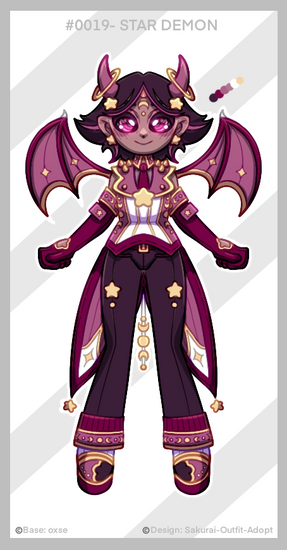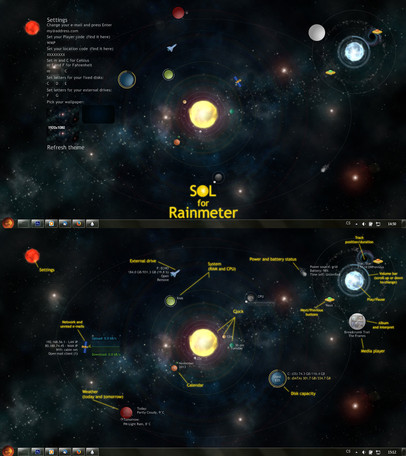HOME | DD
 countschlick — The Solar System to Scale
countschlick — The Solar System to Scale

Published: 2012-11-30 13:17:44 +0000 UTC; Views: 14610; Favourites: 38; Downloads: 693
Redirect to original
Description
. . . and, once again, now for something completely different. My apologies to those that my be looking forward to more pony because this has almost nothing to do with pony. But, I think it is cool (which almost always means that no one else will think it is).I recently saw this image on Wikipedia of the relative size and average distance of the Earth and the Moon . Space is really, really big, and is often much bigger than the colossal objects that float within it, so I was a little surprised to see the distance between these two objects seem so palatable when compared to their sizes.
After doing a bit of the googling, I noticed that no one seemed to have done something similar with the solar system. "Excellent," I thought. "I'll make such an image myself! After all, how hard could it be?"
Well, very. I originally wanted to make the image at least four times longer, but after a bit of calculation, it turned out I was about 8 gigs of RAM short of this being possible. Then I spent too much time looking at sites I could upload 500 gigapixel images to. Then I reeled in my lofty goals a bit more and discovered most programs start crying if you ask them to make or open an image wider than 300 000 pixels. A sub-300000-pixel-wide image it will be then!
Next, I calculated all of the locations and sizes of the largest objects in the solar system with the Moon being the smallest I would include in the image. Then I drew and set the planets, moons, and the Sun in the right places, made a legend, and here it all is! Now I know exactly why no one else has done this before (as far as the Googles is concerned).
Oh, also, for those of you that do not know: I am a huge nerd.
Related content
Comments: 18

👍: 0 ⏩: 0

Three years ago, for my granddaughter’s science fair project, she wanted to do the “walkable scale solar system”, so we went online and found the “Earth as a peppercorn” article (just google it) and decided to do that… “…but Abu! I want to do the Earth as a marble!” she said, so “no problem” says I, as I get the calipers, calculator and a notepad to do the conversion.
For 6th graders… not so walkable anymore.
We placed an 8’ diameter round carpet on the floor of the auditorium to serve as our Sun (2.5m across), in the center of which was our scale display, along with take-away pamphlets explaining the actual distances and scales involved, along with where to find the planets, either linearly (along state road #1) or as a current model (with planets in actual relative positions.
Linearly, we posted water-resistant posterboard signs on the side of the road along the route from San Juan towards Caguas (fudging a bit so that a car could safely park to get out and read the signs).
The Route:
Sun - 2.5 m dia. (8')
Mercury - 8.7 mm - 105 m
Venus - 2.2 cm - 195 m
Earth - 2.3 cm (1”) - 270 m (1 AU)
-Moon - 6 mm (about ¼”)- 70 cm (about 28”) from Earth
Mars - 1.2 cm - 412 m
Asteroid Belt - 2 mm (ground to dust) - 540-945 m
Jupiter - 25 cm (about the size of a basketball)- 1.4 km
Saturn (planet) - 21 cm (about the size of a volleyball) (+ rings - 45 cm across) - 2.6 km
Uranus - 9.1 cm (slightly smaller than a softball) - 5.2 km
Neptune - 8.9 cm (slightly smaller than a softball) - 8.1 km
Pluto/Eris/Kuiper Belt – 1 mm / 1 mm / packet of restaurant salt - 8-15 km
For the then-current model (March, 2012), Saturn, Mars and Earth were on one side of the Sun, Mercury and Venus were off to one side, and everything else was all over the place on the opposite side of the Sun… so we overlaid the positions of the planets on a map of the city and spoke with the businesses that approximated the locations, where we arranged to place the 3D scale planets with a small display and relevant information.
Note that Saturn was almost 11 km (7 miles!) from Jupiter, on opposite sides of the Sun!
You want a sense of scale? See jaws drop? Show them a pinhead (about 2 mm in diameter). Show them a marble. Tell them that the marble is Earth and the pinhead is ALL THE MATERIAL in the asteroid belt between Mars and Jupiter. Now ask them to imagine the entire pinhead turned into talcum powder and spread out in an area as wide as a 10-lane highway for a distance of two miles, which is the linear circumference of the asteroid belt at that scale approximated for depth.
Kinda calls BS on the asteroid sequence of Empire Strikes Back, don’t it?
Interstellar distances? At this scale, Proxima Centauri, our nearest neighbor at a paltry 4.3 light years distance, would be 72,000 km away from the Sun at this scale… that is FIVE TIMES the full-size distance between the Earth and the Moon. That’s circling around the world TWICE at the Tropic of Cancer (almost…).
Oh, yeah… and Proxima Centauri is about 36 cm across…
👍: 0 ⏩: 0

Found this via random googling 
It always blows my mind when I think about the scale of the universe, at pretty much any level. When I think about it, I tend to get frustrated with the way things are generally portrayed - you get a ton of info on relative sizes, but zilch on relative distances. I feel like the distances are even more illuminating than the sizes, yet hardly anyone seems to care.
Bill Nye's demonstration has always stuck with me. In his the Sun is a large balloon (like a beach ball), the earth is a small marble, and neptune is two miles away. There is a reason you can't see Uranus or Neputune with the naked eye!
The scales help you understand some things, like why Astrophysicists are pretty sure the Oort cloud (aka the source of comets) exists, yet it has not been observed. The reason for that is, the objects (comets waiting to happen) are the size of asteroids (i.e. pretty small), yet are further away from Neptune than Neptune is from the Sun. They are tiny, dim, and a long, long way away - our current telescopes don't have a prayer of spotting them.
On the flip side, we can and do see galaxies that are billions of times further than the Oort cloud, because they are billions of times brighter. Even then, though, they are little smudges at best. Still, I find that pretty freaking amazing!
It's just as bad going the other direction. If the proton in the center of a hydrogen atom is the head of a pin, then its lone electron orbits at roughly the outer edge of a football stadium. And when you crack open that proton? Pretty much nothing there. Just three teeny little quarks swinging around each other - most of the rest of it is empty space.
You put all that together, and you realize that for the most part the Universe isn't even there. It's empty space all the way through, with the exception of what amounts to a tiny rounding error holding everything together. It blows and re-blows my mind any time I think about it too hard.
👍: 0 ⏩: 0

thank you very much, I was looking for something similar to appreciate the scale.
👍: 0 ⏩: 0

once again I will repeat what I alwasy say in astronomy - we are that small?
O_O
Woaaaaaaaaaaaaaaaaaaaaaaaaaaaaaaaaaaaaaaaaaaaaaaaaaaaaaaaaah.*
*I say this in my head
👍: 0 ⏩: 0

Pluto got what it deserved. Planet-hood is hard work. If you are not willing to clear your orbit of planetesimals, don't expect pity from the big boys or the little greeblies that live one them.
👍: 0 ⏩: 1

My gosh, this is so cool! I remember one time, my brother's class decided to do a scale model of the solar system. We ran out of space and had to go back and forth several times. Everyone (except me) regretted including Pluto as a planet.
👍: 0 ⏩: 1

MY dad works at the CU Boulder observatory, and there's a scale model of the solar system that starts right outside and stretches about a mile down the sidewalk. I've walked it several times; fun stuff.
👍: 0 ⏩: 0

The following videos...will BLOW. YOUR. MIND.
[link]
[link] (This link starts @ 4:35. Watch to about 6:05.)
...Were not even dust.
👍: 0 ⏩: 0

Yay, astronomy nerd here. I love this, and I hope to see more stuff like this, if you're willing to put the time into it
👍: 0 ⏩: 0

Wow, this is impressive. I'm surprised no one has done this before. This must have been quite an undertaking, since it's to scale and all. Must have been quite a lot of math and planning. Job well done!
👍: 0 ⏩: 0

Count_ you so sporadic, & yet still fun.
& why yes,
I do enjoy a good "stellar" pun.
Do forgive that one,
I have too much comment "space" available to me.
.
👍: 0 ⏩: 0

Very nice, now go back to you mane styling hole we're waiting on the cmc
👍: 0 ⏩: 0






























